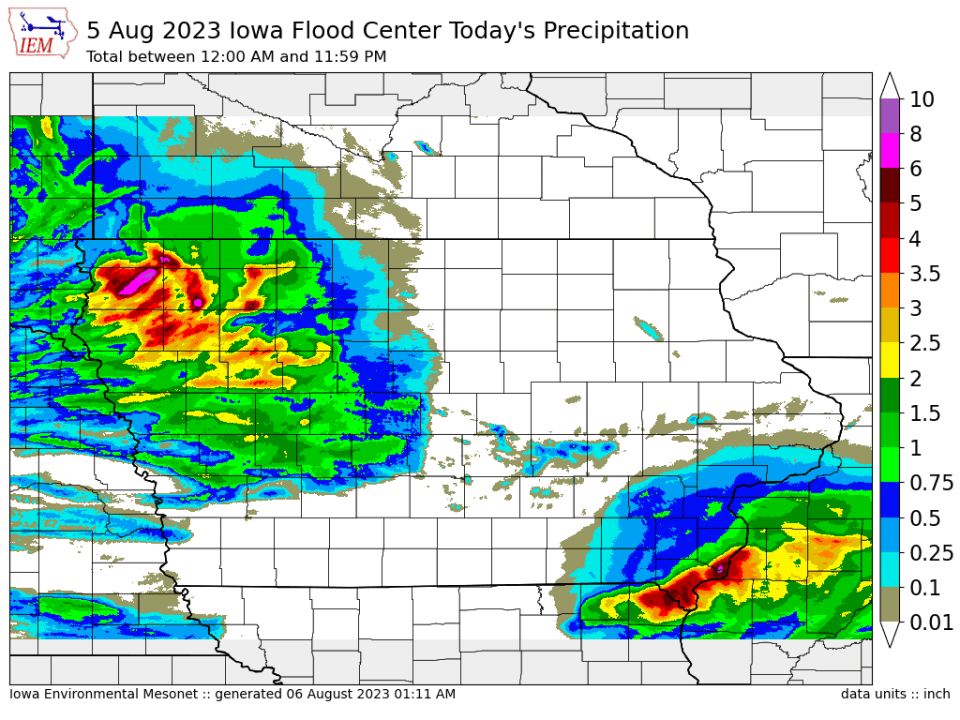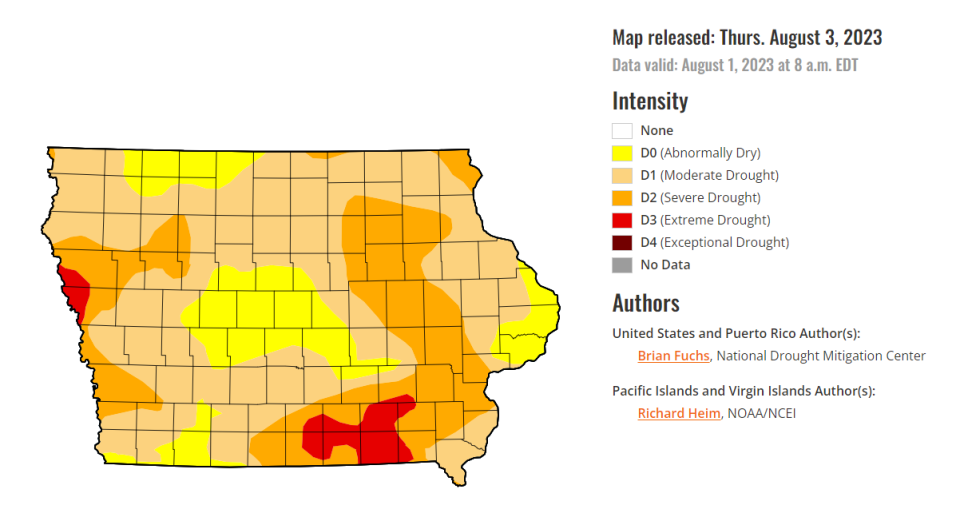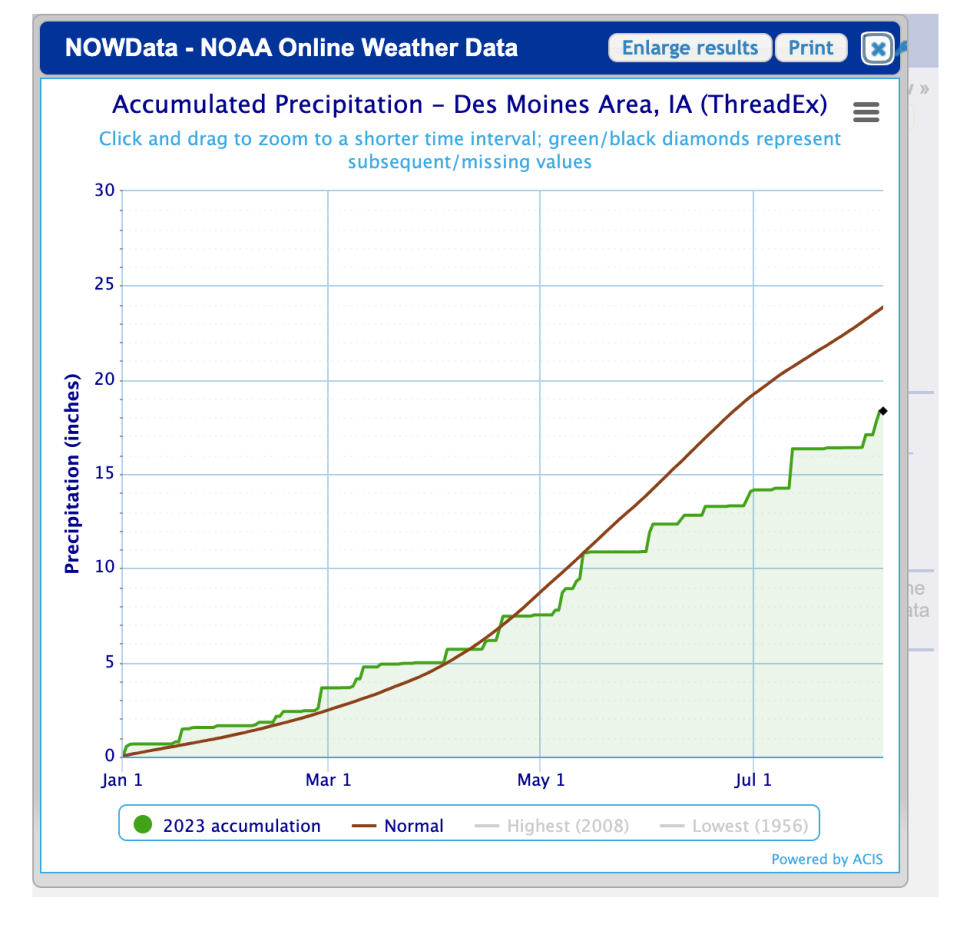It was a rainy Iowa weekend. See the rainfall totals and how much more is coming.
Rain poured over most of Iowa this weekend with some areas getting more than 4 inches and one community in the far northwest corner seeing 9 inches.
The rainfall will do some to improve Iowa's drought, which is affecting the entire state, but was "by no means a drought buster" in some areas with the most severe conditions, said state climatologist Justin Glisan. It did, however, come just in time to help farmers get a more robust crop this fall.
Clouds give way to some sun, but a few afternoon showers return north today. The remainder of the week will be slightly below normal, with periods of showers and storms. Tues night/Wed and again Thu night/Friday. #iawx pic.twitter.com/e9s4ob0aIC
— NWS Des Moines (@NWSDesMoines) August 7, 2023
Roger Vachalek, a National Weather Service meteorologist, said Sac, Ida and Crawford counties saw between 2 and 4 inches of rainfall. Nevada, which is closer to the Des Moines metro, saw anywhere from 4 to almost 6 inches.
Harder rain fell in Decatur County near Lamoni, where totals were about 3 to 4 inches over the past three days.
While Monday was expected to have fewer showers, more rain should fall on and off for the rest of the week, bringing with it cooler temperatures.
In terms of rainfall conditions Monday, Vachalek said, "nothing much today. Just looks like a few sprinkles or light showers over northern Iowa this afternoon, and then more chances for rain coming up for Tuesday night and Wednesday, and again Thursday night into Friday morning."
More: Drought forces Des Moines Water Works to raise Raccoon River flashboards for third year
What were the weekend rainfall totals across Iowa?

The Des Moines metro saw between 1 and 1.5 inches of rain over the weekend. Most rainfall fell in the northwestern and southeastern portions of the state. Here are some highlights:
Ames: 3.3 inches
Nevada: 4.8 inches
Sioux Center: 9 inches
Spring Grove: 8.5 inches
Wayland (1 hour southwest of Muscatine): 7.3 inches
How the rain has impacted Iowa's drought

Over the last week, western and southern Iowa saw rainfall totals that were anywhere from 300% to 400% the average amount. Some areas got a month's worth of rainfall, according to Glisan.
Drought is measured in categories that range from D0 (abnormally dry) to D4 (exceptional drought). This is the third year of drought in Iowa, but more specifically, the 161st week of D1 or higher somewhere in the state.
A new drought monitor report will be released Thursday, which will show whether last week's rainfall had much of an impact.
The outlook for August, however, shows elevated signals for more cooler and wetter conditions at an optimal time for crops' development. Nevertheless, it will take a lot more rainfall to eradicate the drought.
"If we see a continued pattern where we're in an active storm track, like we've been in over the last several days, we're definitely going to chip into those longer term deficits," Glisan said. "But we're still going to need several months of above average precipitation to really help extinguish the most pervasive parts of the drought."
The recent temperature changes have caused a cooler drought, according to Glisan. July was about 2 degrees below average, which has helped prevent a more intense drought from harming corn and soybeans as they start to use more water, he said.
"We've had temperatures anywhere from 2, 4, even 5 degrees below average, so we're looking at a cool drought," he said. "Now that might be counterintuitive, but basically when you see drought exist across the state ... they're typically coupled with very warm temperatures."

How the rainfall will impact Iowa crops
It's late in the growing season, according to Iowa State University Extension field agronomist Meaghan Anderson, and what Iowa saw this weekend is what she likes to call the "just in time rainfall." This recent spout of rain came at just the right moment to help the crop yield.
"A lot of people who got an inch and a half or 2 inches of rain, that may be enough to help us really finish this crop out well without putting it under too much stress," Anderson said.
More: Cost to rent Iowa farmland sets record high this year, a new ISU survey says
At this point in the season, the corn is filling out its ear and the soybeans are flowering and working to fill those pods with seeds. By this point, the number of plants isn't going to change. The number of ears on each corn stalk (normally one) is well established.
"What we are going to see from a yield perspective relating to this rainfall is those kernels that the corn does have should be able to fill more," Anderson said.
While the kernels become more dense, soybeans are a little more flexible. The rain may help by adding more pods to the plants, and the number of seeds in those pods.
"We still have quite a bit of time here where we can take advantage of this rainfall," Anderson said. "Hopefully it results in better yields than we would've had otherwise."
What farmers don't want with rain is the oversaturation of roots because it can cause the plant a lot of stress. This is unlikely as the soil is quite dry to begin with, so Anderson hopes that the water is quickly absorbed to not affect crop growth.
"Even in central Iowa where we have had more rainfall, at least the top 6 to 12 inches of our soil was fairly dry because our crops used so much moisture this time of year," she said.
Noelle Alviz-Gransee is a breaking news reporter at the Des Moines Register. Follow her on Twitter @NoelleHannika or email her at NAlvizGransee@registermedia.com.
This article originally appeared on Des Moines Register: Weekend Iowa rainfall totals and what to expect for the upcoming week.

